Showing Spotlights 665 - 672 of 2879 in category All (newest first):
 Researchers a new strategy for designing Pickering emulsion based on halloysite nanotubes and exploring chitosan and pectin as thickener additives for the development of cleaning and preservation applications for cultural heritage. This novel and facile strategy to prepare hydrogel containing oil-in-water stable emulsion offers an alternative route to prepare formulations with high performance and based on sustainable materials for the controlled cleaning and preservation of stone-based artworks.
Researchers a new strategy for designing Pickering emulsion based on halloysite nanotubes and exploring chitosan and pectin as thickener additives for the development of cleaning and preservation applications for cultural heritage. This novel and facile strategy to prepare hydrogel containing oil-in-water stable emulsion offers an alternative route to prepare formulations with high performance and based on sustainable materials for the controlled cleaning and preservation of stone-based artworks.
May 8th, 2019
 Rare earth metals and alloys that contain them are used in many devices that people use in their everyday lives. Whereas the research on two-dimensional (2D) nanomaterials such as graphene, hexagonal boron nitride, MXenes, transition metal dichalcogenides, or metal-organic frameworks moves full-steam ahead, overview reports on 2D rare earth materials are, well, rare. However, with the electron confinement within mono- or multi-layers, the optical, magnetic, electric, catalytic, and adsorptive properties of ultrathin 2D rare-earth nanomaterials may also vary remarkably from those of the bulk phase, opening up great opportunities for applications in numerous areas.
Rare earth metals and alloys that contain them are used in many devices that people use in their everyday lives. Whereas the research on two-dimensional (2D) nanomaterials such as graphene, hexagonal boron nitride, MXenes, transition metal dichalcogenides, or metal-organic frameworks moves full-steam ahead, overview reports on 2D rare earth materials are, well, rare. However, with the electron confinement within mono- or multi-layers, the optical, magnetic, electric, catalytic, and adsorptive properties of ultrathin 2D rare-earth nanomaterials may also vary remarkably from those of the bulk phase, opening up great opportunities for applications in numerous areas.
May 7th, 2019
 Highly compressible graphene aerogels possess extraordinary properties that exceed the performance of natural materials - superior compressive elasticity; ultrahigh porosity; outstanding tolerance for harsh environment; large specific surface area; high electrical and thermal conductivity. Now, researchers have fabricated graphene aerogel 'bricks' that can be assembled into much larger aerogel structures. These highly oriented and dense microstructures possesses arbitrary macroscale, outstanding compressive strength, superelasticity, and high conductivity.
Highly compressible graphene aerogels possess extraordinary properties that exceed the performance of natural materials - superior compressive elasticity; ultrahigh porosity; outstanding tolerance for harsh environment; large specific surface area; high electrical and thermal conductivity. Now, researchers have fabricated graphene aerogel 'bricks' that can be assembled into much larger aerogel structures. These highly oriented and dense microstructures possesses arbitrary macroscale, outstanding compressive strength, superelasticity, and high conductivity.
May 6th, 2019
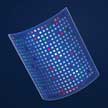 Electronic device versions of the human eye's photoreceptors could potentially be used in a wide range of applications from robotic humanoid vision to artificial retina implantation for vision restoration or even vision extension into a wider range of wavelength. Researchers have now demonstrated that high-performance filterless artificial human photoreceptors can be realized by integrating a novel optical metal/dielectric/metal microcavity structure with vacuum-deposited perovskite photoresponse devices. These easy-to-fabricate artificial photosensors mimic the spectral responses of human color cones and rods.
Electronic device versions of the human eye's photoreceptors could potentially be used in a wide range of applications from robotic humanoid vision to artificial retina implantation for vision restoration or even vision extension into a wider range of wavelength. Researchers have now demonstrated that high-performance filterless artificial human photoreceptors can be realized by integrating a novel optical metal/dielectric/metal microcavity structure with vacuum-deposited perovskite photoresponse devices. These easy-to-fabricate artificial photosensors mimic the spectral responses of human color cones and rods.
May 1st, 2019
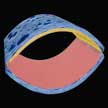 Researchers introduced an exclusive self-charging and self-healing flexible asymmetric supercapacitor power cell proficient to sustainably power-up portable electronics by simply applying mechanical bio-mechanical stresses. This self-charging power cell/package comprises an asymmetric supercapacitor unit sandwiched in-between two parallel connected triboelectric nanogenerators and reveals exceptional output performances. Additionally, this nanogenerator cell exhibits remarkable self-healing behavior.
Researchers introduced an exclusive self-charging and self-healing flexible asymmetric supercapacitor power cell proficient to sustainably power-up portable electronics by simply applying mechanical bio-mechanical stresses. This self-charging power cell/package comprises an asymmetric supercapacitor unit sandwiched in-between two parallel connected triboelectric nanogenerators and reveals exceptional output performances. Additionally, this nanogenerator cell exhibits remarkable self-healing behavior.
Apr 30th, 2019
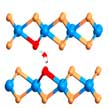 Aqueous rechargeable batteries based on earth abundant materials are promising alternatives to lithium-ion batteries, which are plagued by safety and environmental concerns. These batteries utilize water-based electrolytes, which are safe, low-cost, and environment-friendly, but also possess a much higher ionic conductivity than that of the organic electrolytes. In new work, researchers report an effective and general strategy to transform inactive intercalation hosts into efficient zinc ion storage materials through intercalation energy tuning.
Aqueous rechargeable batteries based on earth abundant materials are promising alternatives to lithium-ion batteries, which are plagued by safety and environmental concerns. These batteries utilize water-based electrolytes, which are safe, low-cost, and environment-friendly, but also possess a much higher ionic conductivity than that of the organic electrolytes. In new work, researchers report an effective and general strategy to transform inactive intercalation hosts into efficient zinc ion storage materials through intercalation energy tuning.
Apr 26th, 2019
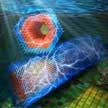 Researchers demonstrate, for the first time, a tellurium@selenium (Te@Se) heterostructure used as a working material in a photoelectrochemical-type photodetector. Specifically, Te@Se nanotube heterojunctions synthesized by epitaxial growth of selenium on tellurium nanotubes exhibit a largely enhanced self-powered photoresponse, significantly improved photocurrent density, and photoresponsivity compared to those of Te or Se nanomaterials.
Researchers demonstrate, for the first time, a tellurium@selenium (Te@Se) heterostructure used as a working material in a photoelectrochemical-type photodetector. Specifically, Te@Se nanotube heterojunctions synthesized by epitaxial growth of selenium on tellurium nanotubes exhibit a largely enhanced self-powered photoresponse, significantly improved photocurrent density, and photoresponsivity compared to those of Te or Se nanomaterials.
Apr 25th, 2019
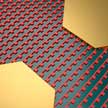 Terahertz (THz) frequencies, which occupy a middle ground between microwaves and infrared light, are seen as the future of wireless communications because they offer a higher bandwidth capacity for data transmission than currently used microwave radiation. Researchers have improved the photoconductive switch, a key optoelectronic element in THz technology, with a perfectly-absorbing photoconductive metasurface. The perfect absorption within this metasurface allows to make the active region of THz wave detectors significantly thinner in comparison to conventional detectors. Apart from reducing the size of THz detectors, it also improves their efficiency.
Terahertz (THz) frequencies, which occupy a middle ground between microwaves and infrared light, are seen as the future of wireless communications because they offer a higher bandwidth capacity for data transmission than currently used microwave radiation. Researchers have improved the photoconductive switch, a key optoelectronic element in THz technology, with a perfectly-absorbing photoconductive metasurface. The perfect absorption within this metasurface allows to make the active region of THz wave detectors significantly thinner in comparison to conventional detectors. Apart from reducing the size of THz detectors, it also improves their efficiency.
Apr 24th, 2019
 Researchers a new strategy for designing Pickering emulsion based on halloysite nanotubes and exploring chitosan and pectin as thickener additives for the development of cleaning and preservation applications for cultural heritage. This novel and facile strategy to prepare hydrogel containing oil-in-water stable emulsion offers an alternative route to prepare formulations with high performance and based on sustainable materials for the controlled cleaning and preservation of stone-based artworks.
Researchers a new strategy for designing Pickering emulsion based on halloysite nanotubes and exploring chitosan and pectin as thickener additives for the development of cleaning and preservation applications for cultural heritage. This novel and facile strategy to prepare hydrogel containing oil-in-water stable emulsion offers an alternative route to prepare formulations with high performance and based on sustainable materials for the controlled cleaning and preservation of stone-based artworks.
 Subscribe to our Nanotechnology Spotlight feed
Subscribe to our Nanotechnology Spotlight feed





